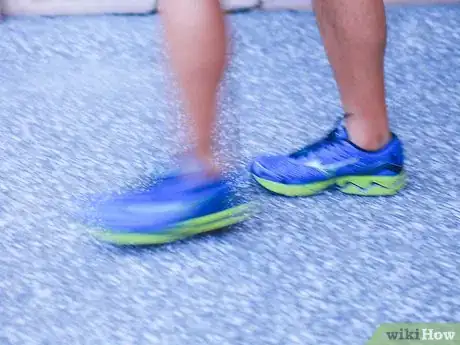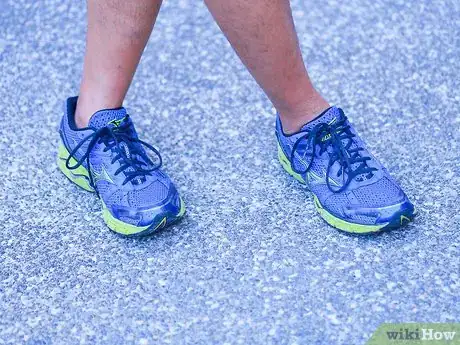This article was co-authored by Kai Ng. Kai Ng is a USATF and RRCA Certified Running Coach at Run Coach Kai. Kai has competed in over 55 races and over 15 marathons, and has trained with 16x USA and World record holder Patti Catalano Dillonso. He specializes in coaching runners of all levels and showing people that everyone can be a runner. Kai is committed to helping his clients reach their goals by showing them how to run with proper form and holding them accountable to train consistently.
There are 9 references cited in this article, which can be found at the bottom of the page.
This article has been viewed 17,837 times.
Running is a great exercise and beloved past-time of many people. It is an activity that contributes to long-term cardiovascular health and overall fitness. However, it is important that runners prepare their bodies ahead of time for more efficient runs and to avoid injury. For example, it is essential that runners are adequately hydrated and have performed a warm-up before a run.
Steps
Fueling Your Body
-
1Drink plenty of water to stay hydrated. While there is no specific amount of water that is recommended by fitness experts before a run, you will want to hydrate before and during your run. [1]
- It is not a good idea to do a long run without having a substantial drink of water beforehand. It is certainly possible to run without hydrating first, but this will make your run more difficult and you risk severe dehydration.
- Fitness experts do recommend that you make sure your urine is a light yellow color before heading out for a run. If it is light in color you are well hydrated. [2]
- Try drinking at least 8 to 16 ounces of water before a run to start. You may need more or less.
- You should also drink during your run. Most people will sweat out 24 to 32 ounces of water per hour during exercise. You should aim to replace 75% of this during a run, so it is suggested that you drink between 18 to 24 ounces of water per hour of exercise.
-
2Try a sports drink instead of water. This is especially important if your sodium levels tend to be low. [3]
- Sodium is a very important nutrient for your body. You sweat out sodium when you exercise, so it is important to replace it.
- If your skin is very salty after a run, you are losing sodium.
- Most people lost 800-1500mg of sweat per hour when they exercise.
- Sports drinks like Gatorade contain sodium and electrolytes; 8 ounces of Gatorade has 110mg of sodium and Gatorade Performance contains 200mg. These are great options for sodium replacement.
- You can also put a little bit of salt into your drinking water if you don't care for sports drinks.
Advertisement -
3Have a healthy snack or small meal. Your body doesn't just need water and sodium to fuel itself. [4]
- It is important that you have a balanced snack with protein and carbohydrates before a run.
- Pairing a protein and carbs can help you prevent a sudden drop in blood sugar while running.
- Protein intake can help you to burn fat during exercise.
- Nutritionists recommend a light meal or snack such as a tortilla with banana, honey and almond butter.
- Alternatively, another good pre-run snack is an oatmeal with nuts and dried fruit or yogurt with honey and granola
Dressing For a Run
-
1Make sure you have the right footwear. A good pair of running shoes can save your feet from strain from running. [5]
- The American Orthopedic Foot and Ankle Society recommends a running shoe for anyone who jogs or runs, as these can prevent painful long-term injuries such as shin splints and tendinitis.
- Running shoes are specialized by foot type, gait type, and training styles.
- When purchasing athletic shoes, you should try them on after a workout or run when your feet are largest.
- The shoe should have a firm grip from your heel to your toe. Well-fitting athletic shoes should be comfortable when you try them on.[6] You shouldn't need to "break them in".
- When purchasing athletic shoes it is best to go to a specialty store to get a fitting. The sales person can determine which shoe is best for your training level, gait style, and foot type.
-
2Dress warmly in cold weather. In the cold you will want to make sure any exposed skin is protected. [7]
- Most runners suggest dressing as if it is 20-30 degrees warmer than it is outside.
- For example, if it is 30 degrees outside you can get by comfortably with a thin thermal and a light jacket. As you run, you will generate heat.
- Wear thermal leggings or sweat pants for winter running.
- In the cold, avoid cotton as it will soak up sweat and leave you cold and damp.[8]
- On very cold days, make sure your ears, face, and hands are well covered.
- Wear thick socks in cold weather. If it is very damp and cold, you can wrap your feet in plastic bags inside your shoes to keep them dry.
-
3Wear light clothing in hot weather. You will want to avoid wearing non-breatheable fabrics and you should always make sure you have protection from the sun. [9]
- Wear apparel that is light in color, lightweight, and has vents or mesh.
- Fabrics such as microfiber polyesters and cotton blends are recommended.
- Also wear a hat and shades in the hot sun.
- Apply an SPF 30 or higher sunscreen to avoid skin damage from the sun. You won't want to get sunburn!
Warming Up For A Run
-
1Start warming up for a run by walking. You always want to warm up before running to get your muscles toned and ready for exercise. [10]
- Walk gently for 3-5 minutes before a run.
- This will stretch and move your muscles, tendons and joints and transition your body into a workout.
- This activity will enhance blood flow to the muscles you need to use for running.
- This initial warm up is very low-intensity and can be essential for runners coming back from an injury.
-
2Add strides to your walking. Do five or six 100 meter (330 ft) strides. These are also called "pick-ups" and will help to increase blood flow to the muscles and help your body transition from walking to running. [11]
- Jog slowly for at least 2 minutes or more.
- Gradually accelerate over the course of 60 to 100 meters (200 to 330 ft), then decelerate.
- After each interval, walk around and stretch out your legs for at least 90 seconds.
- Keep your steps quick and short as you do the jogging intervals to avoid injury.
-
3Perform some dynamic stretches. Dynamic stretching uses controlled leg movements to improve range of motion.[12] This will loosen up muscles and help to increase heart rate, body temperature, and blood flow to help you run efficiently.[13]
- Avoid stretches where you hold a stretch for 30 seconds or more. This can actually contribute to injury if done before a run.
- Skipping is an example of a dynamic stretch. Try doing this for 25–50 meters (82–160 ft), increasing the height and intensity of your skip as you go.
- Backwards jogging is another type of dynamic stretch.
- Try doing the side step or shuffle. Step to the side in 10–20 meter (32.8–65.6 ft) intervals from side to side, starting at a walking pace and increasing to a jog.
- Do the weave step or grapevine. Step your right foot to the side, then step your left foot behind your right foot. Repeat this for 10–20 meters (32.8–65.6 ft) in one direction, then repeat in the other direction. Start at a walking pace and increase to a jogging pace.
Expert Q&A
Did you know you can get expert answers for this article?
Unlock expert answers by supporting wikiHow
-
QuestionWhat preparations are done before running?
 Clare FlanaganClare Flanagan is a former competitive NCAA Division I cross-country runner for Stanford University. She has been running for over a decade, previously having won six Class A State Championships in Minnesota, set a Class A State record in the 1600m, and qualifying for the Nike Cross Country Nationals.
Clare FlanaganClare Flanagan is a former competitive NCAA Division I cross-country runner for Stanford University. She has been running for over a decade, previously having won six Class A State Championships in Minnesota, set a Class A State record in the 1600m, and qualifying for the Nike Cross Country Nationals.
Former Competitive Runner
-
QuestionWhat should you do to improve endurance?
 Kai NgKai Ng is a USATF and RRCA Certified Running Coach at Run Coach Kai. Kai has competed in over 55 races and over 15 marathons, and has trained with 16x USA and World record holder Patti Catalano Dillonso. He specializes in coaching runners of all levels and showing people that everyone can be a runner. Kai is committed to helping his clients reach their goals by showing them how to run with proper form and holding them accountable to train consistently.
Kai NgKai Ng is a USATF and RRCA Certified Running Coach at Run Coach Kai. Kai has competed in over 55 races and over 15 marathons, and has trained with 16x USA and World record holder Patti Catalano Dillonso. He specializes in coaching runners of all levels and showing people that everyone can be a runner. Kai is committed to helping his clients reach their goals by showing them how to run with proper form and holding them accountable to train consistently.
Certified Running Coach
-
QuestionHow can I choose a treadmill?
 Kai NgKai Ng is a USATF and RRCA Certified Running Coach at Run Coach Kai. Kai has competed in over 55 races and over 15 marathons, and has trained with 16x USA and World record holder Patti Catalano Dillonso. He specializes in coaching runners of all levels and showing people that everyone can be a runner. Kai is committed to helping his clients reach their goals by showing them how to run with proper form and holding them accountable to train consistently.
Kai NgKai Ng is a USATF and RRCA Certified Running Coach at Run Coach Kai. Kai has competed in over 55 races and over 15 marathons, and has trained with 16x USA and World record holder Patti Catalano Dillonso. He specializes in coaching runners of all levels and showing people that everyone can be a runner. Kai is committed to helping his clients reach their goals by showing them how to run with proper form and holding them accountable to train consistently.
Certified Running Coach
References
- ↑ http://www.womenshealthmag.com/fitness/running-and-drinking-water
- ↑ http://www.womenshealthmag.com/nutrition/signs-you-are-dehydrated
- ↑ http://www.womenshealthmag.com/fitness/running-and-drinking-water
- ↑ http://www.menshealth.com/nutrition/are-you-eating-right-your-run
- ↑ http://www.aofas.org/footcaremd/how-to/footwear/Pages/Selecting-Athletic-Shoes.aspx
- ↑ Kai Ng. Certified Running Coach. Expert Interview. 12 February 2021.
- ↑ http://www.boston.com/health/2014/11/02/how-dress-for-winter-running-from-head-toe/awTk1kFsCtdf0LT65BOPZM/story.html
- ↑ Kai Ng. Certified Running Coach. Expert Interview. 12 February 2021.
- ↑ http://www.runnersworld.com/the-starting-line/running-heat
- ↑ http://www.runnersworld.com/the-starting-line/how-and-why-you-should-warm-up-before-a-run
- ↑ http://www.runnersworld.com/the-starting-line/how-and-why-you-should-warm-up-before-a-run
- ↑ Kai Ng. Certified Running Coach. Expert Interview. 12 February 2021.
- ↑ http://www.runnersworld.com/the-starting-line/how-and-why-you-should-warm-up-before-a-run
About This Article
To prepare for running, drink at least 8 ounces of water or a sports drink before your run, which will help prevent dehydration. You should also fuel up with a healthy snack that contains both protein and carbohydrates, like nuts and dried fruit or yogurt with honey and granola. Also, go for a 3-5 minute walk before your run and then jog for 2 minutes to warm up and increase blood flow to your muscles. After you're finished jogging, perform some dynamic stretches, like skipping or side steps. To learn how to dress for a run, scroll down!


































































